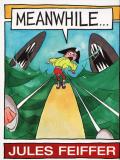Jules Feiffer Tries Yet Another New Thing
Christopher Borrelli’s interview with Jules Feiffer in the Chicago Tribune brings out several interesting remarks about his multifaceted career:
Q: You've done so many different things — where do your biggest royalty checks come from?Feiffer’s current project is Kill My Mother, a graphic novel drawn in a film noir style he expects his fans not to recognize.
A: (Laughs.) A diversity of places. Mostly children's books, I suppose. A lot of it comes from "The Phantom Tollbooth," the book I did with Norton Juster. That book has become a great annuity for me, a sizable one. It just celebrated its 50th anniversary, and it's amazing how well it still sells. It's also amazed me how much the book and my art has been remembered. At the time, in the early '60s, it was work that I didn't really appreciate that much. I had difficulty doing it and didn't feel like I was a natural at that kind of thing.
Q: Was it hard because so much of "Phantom Tollbooth" feels abstract?
A: No. Maurice [Sendak], in the new edition, wrote that I was one of the few cartoonists who can illustrate ideas. I've always felt that illustrating the abstract — drawing ideas — is one of the primary jobs of the cartoonist. . . .
Q: How did the death of Maurice Sendak affect you?
A: When you said his name my heart sank. I loved him. We rarely saw each other because he was in Connecticut. But we had deep affection for each other. When he had his first heart attack, he was in London and I happened to be in London, so I spent time with him. But we were very different in temperament. He was much more of a Russian Jew than I was, much more given to doubts of depression and grimness, and I never entirely lost some of the giddy boy-cartoonist traits I've always had. We would sit for hours and talk.
Q: And like Maurice, you seem too acidic to write children's books.
A: True. (Children's books) were a means to an end, a way to make me a living. Children's books were not a passion. That's how I felt in the '50s — once I met Maurice, I didn't think I would dare compete with him. But years later, after one of my plays, "Grown Ups," got beat up badly, I thought I needed another obsession. My idea was about this kid cartoonist, and that became "The Man in the Ceiling." I wrote it, then I called Maurice, and he gave me the name of his editor, Michael di Capua, and I've been with Michael ever since.
Yes, thought I could write a graphic novel, someone else could illustrate it. But as it developed, it ended up being long, starting in 1933, then switching to 1943, going from the Depression to World War II. And I couldn't find anyone to draw it right. For this kind of Chandler-Hammett noir thing, you need shadows, rain. So I had to learn how to do it. Fortunately, I have Turner Classic Movies. I record all this film noir, "The Maltese Falcon," "The Big Sleep," and hit pause on my remote. That's been my research medium. It will not be drawn (in a) traditional Feiffer style. I stole from [Will] Eisner. I hope it will be finished by the end of next year.Last month Feiffer told Publishers Weekly about this project:
Feiffer went on to explain that, “when I started out in the comic book business, I didn’t plan on producing social and political commentary,” and said he really wanted to produce action/adventure comics strips like his cartoonist heroes, Will Eisner (The Spirit) and Roy Crane (Wash Tubbs). “But I couldn’t draw like them. Since I had no qualifications and couldn’t imitate them, I tried to do my own thing,” Feiffer said.The Tribune interview also contains remarks about Hugh Hefner as an editor, Philip Roth as a joker, Jack Nicholson starstruck by Warren Beatty, and more.



No comments:
Post a Comment